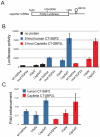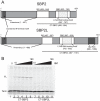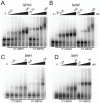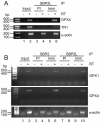Selenocysteine insertion sequence binding protein 2L is implicated as a novel post-transcriptional regulator of selenoprotein expression
- PMID: 22530054
- PMCID: PMC3328465
- DOI: 10.1371/journal.pone.0035581
Selenocysteine insertion sequence binding protein 2L is implicated as a novel post-transcriptional regulator of selenoprotein expression
Abstract
The amino acid selenocysteine (Sec) is encoded by UGA codons. Recoding of UGA from stop to Sec requires a Sec insertion sequence (SECIS) element in the 3' UTR of selenoprotein mRNAs. SECIS binding protein 2 (SBP2) binds the SECIS element and is essential for Sec incorporation into the nascent peptide. SBP2-like (SBP2L) is a paralogue of SBP2 in vertebrates and is the only SECIS binding protein in some invertebrates where it likely directs Sec incorporation. However, vertebrate SBP2L does not promote Sec incorporation in in vitro assays. Here we present a comparative analysis of SBP2 and SBP2L SECIS binding properties and demonstrate that its inability to promote Sec incorporation is not due to lower SECIS affinity but likely due to lack of a SECIS dependent domain association that is found in SBP2. Interestingly, however, we find that an invertebrate version of SBP2L is fully competent for Sec incorporation in vitro. Additionally, we present the first evidence that SBP2L interacts with selenoprotein mRNAs in mammalian cells, thereby implying a role in selenoprotein expression.
Conflict of interest statement
Figures








References
-
- Allmang C, Krol A. Selenium: its molecular biology and role in human health. Springer; 2006. SECIS RNAs and K-turn binding proteins. A survey of evolutionary conserved RNA and protein motifs. pp. 51–61.
Publication types
MeSH terms
Substances
Grants and funding
LinkOut - more resources
Full Text Sources
Molecular Biology Databases

